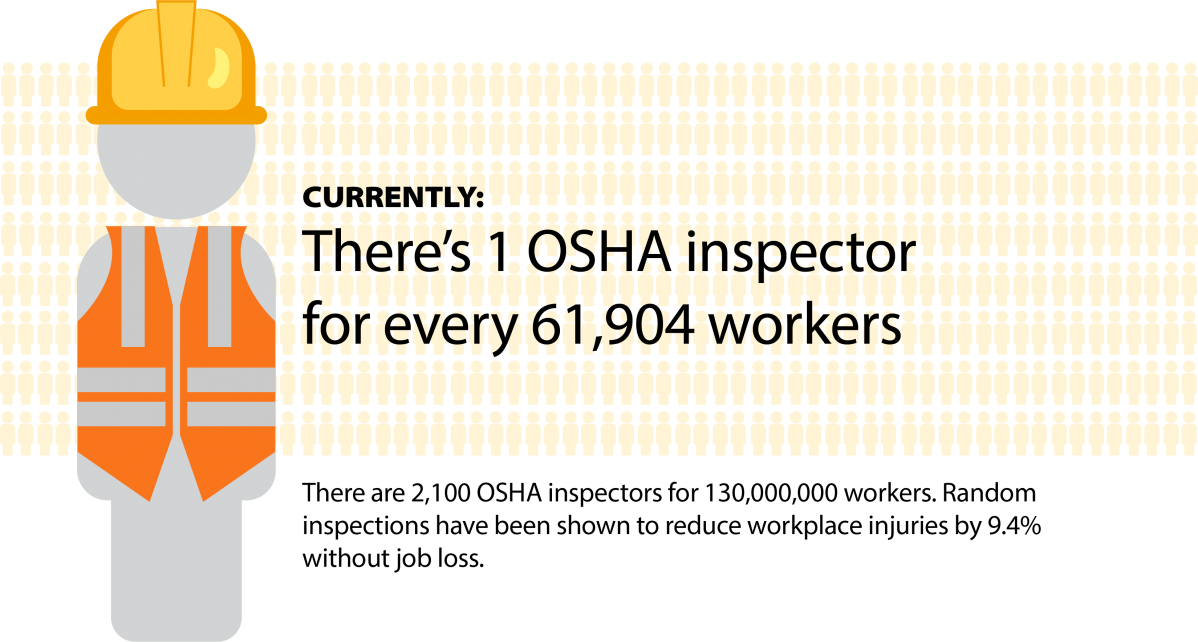Worker Health, Safety & Power
Workers’ overall bargaining power has declined for decades and resulted in stagnant wages, soaring inequality, and a deterioration in job quality - problems that cut deeper along lines of race, gender, disability, and immigration status.
The COVID-19 crisis has laid bare these deep structural inequities in our economy, put a particular emphasis on the importance of workplace health and safety, and highlighted the urgent need for workers to build power in workplaces and the economy overall. We seek to support workers organizing and to pursue policy solutions that build worker power. Areas that need to be addressed include:

Health and safety measures that protect workers in the workplace during the COVID-crisis and beyond:
During the pandemic, OSHA has been largely absent in its enforcement of health and safety guidelines during the pandemic. OSHA has been flat-funded for years, resulting in inadequate staffing to perform timely inspections and citations even before the pandemic. Currently there are 2,100 OSHA inspectors for 130,000,000 workers. Random inspections have been shown to reduce workplace injuries by 9.4% without losing jobs.
Increased inspections and enforcement could have a significant impact on the safety of workers during and after the pandemic. During the pandemic OSHA has failed to create an Emergency Temporary Standard for COVID workplace safety. The creation of a temporary standard and increased funding for State and Federal OSHA programs should be a top priority for Congress and the President in 2021.
Continue to strengthen workers’ right to organize and workers’ bargaining strength:
Labor unions have proven to be a critical part of the public health system. While workers continue to wait for federal and state occupational safety regulatory agencies to intervene, unions have filled a gap where governments have failed – holding employers accountable to their duty to ensure a safe working environment.
A recent study in HealthAffairs journal reports “Health care worker unions were associated with a 1.29 percentage point mortality reduction, which represents a 30% relative decrease in the COVID-19 mortality rate compared to facilities without health care worker unions”. Simply put, worker organizations save the lives of workers, their clients, and the general public. Currently nearly 50% of workers are legally barred from forming a union or collectively bargaining. The growth in the number of workers employed through the so-called “gig economy” has exacerbated the growth in workers being misclassified as independent contractors. Workers must have the ability to freely organize without fear of employer interference to advocate where the government is unable or unwilling to do so.
Federal action is desperately needed to create real penalties for employers who interfere in their workers’ right to organize, prevent employers from being able to indefinitely postpone union elections, reclassify many workers as employees, and ban right-to-work laws. More must be done to strengthen workers’ strength in collective bargaining, such as creating binding arbitration rights for employees negotiating their first contracts.

Raising standards on government spending:
Many who are doing the most essential work during the pandemic are the lowest paid workers. Sadly too many of these substandard wage jobs are in industries and areas that are largely or entirely publicly funded, such as homecare workers, nursing home workers, custodial workers and childcare workers. Their pay should reflect the critical work they do, and we must ensure that government policies, procedures, and reimbursement rates allow these workers to make a living wage. Public tax dollars must not be used to lower wage standards. This includes ending the abuse of contracting out in-state services to make it harder to contract out for the sole purpose of reducing wages and benefits.
Maine must also raise reimbursement rates for direct care services that allow agencies to pay their employees a living wage, and establish a wage board to ensure responsible minimum wages for the industries are set.
Remove Barriers to Meaningful Work for People with Disabilities
In Maine in 2018, before the pandemic, the percentage of working-age people with disabilities working full-time/full-year was 21.2 percent. [1] People with disabilities remain an untapped resource whose greater employment would be mutually beneficial to individuals and the community. Maine is an “Employment First”state, meaning that when providing services or supports to a person with a disability, a state agency or state contracted service shall offer to the person, as the first and preferred service or support option, a choice of employment services before offering any other service. [2] Maine must fully implement “Employment First” while simultaneously waging a campaign to change public perception about the ability or desire of people with disabilities to work.
What you can do to help
The Peer Workforce Navigator Project is a coalition of community-based organizations in partnership with the Maine Department of Labor (MDOL). We help people make connections with education and training, apprenticeships, unemployment insurance, healthcare, public benefits, and things they need to get and keep a good job.
Each organization brings expertise, networks, relationships, and trust built over time to provide reliable, up-to-date information and opportunities to community members and to support economic empowerment for all workers in Maine. Our coalition includes: Food AND Medicine, Gateway Community Services Maine, Maine AFL-CIO, Maine Equal Justice and Prosperity Maine.
This project is built and informed by our communities and for our communities. There is always space for people looking to join us in this project! Learn more and get involved!
[2] 26 MRS Chapt. 41, Sec. 3401-sec. 3403